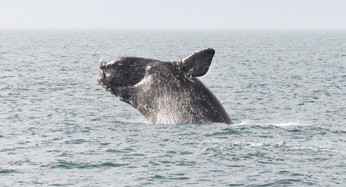By Monica Pepe, Policy Manager, Conservation and Education, Whale and Dolphin Conservation
 A North Atlantic right whale breaches. © nmfs.noaa.gov
A North Atlantic right whale breaches. © nmfs.noaa.gov
When he was just one year old, a North Atlantic right whale named Kingfisher became entangled in fishing gear. In a span of six weeks, he went from swimming freely off the coast of Georgia up to Maine, then back down to Georgia all while towing several feet of rope and attached buoys that had wrapped around his right flipper and over his body. A disentanglement effort was attempted with the assistance of the United States Coast Guard cutter Kingfisher (the whale’s namesake) where many of the lines around the body were removed, but in the end was unsuccessful in retrieving the rope wrapped tightly around his flipper. Today, 13 years later, Kingfisher still lives with his right flipper entangled, where the rope continues to tighten, cutting into flesh and bone, causing chronic injury and pain.
Kingfisher’s story demonstrates that entanglement in fishing gear presents not only a threat to the survival of the species, but also to the welfare of the individuals that remain. On average, a lethally entangled whale will suffer for at least six months before succumbing to the resulting infection. At least 83% of right whales have been entangled at some point during their life, with many individuals suffering from multiple entanglements. While we can acknowledge that disentanglement teams have saved the lives of many whales and significantly contributed to their welfare, disentanglement itself is a Band-Aid put onto a problem that needs to be prevented from happening.
We shave much to learn about how whales become entangled in fishing gear. It appears that whales do not pull away, but instead roll into the gear they encounter. Scientists often find gear wrapped around their backs, flukes, flippers, or caught through their mouths. What is clear, however, is that their entire range along the U.S. East Coast and Canada is shared with productive fishing areas where fixed gear is set to catch lobsters, crabs, and other commercially valuable fish. It is estimated that over 160,000 lines of rope are in use all along the this area, leaving a labyrinth of fishing gear through which whales must try to navigate.
We at Whale and Dolphin Conservation (WDC) recognize the importance of the fishing industry and emphasize that there is no intent from fishermen to harm whales. Yet this accidental bycatch of whales and dolphins poses the single largest global threat to marine mammals. Here in the Atlantic, WDC holds a federally appointed seat on the Atlantic Large Whale Take Reduction Team, where we work with fishermen, conservation groups, scientists and state and federal agency representatives to address this complex threat. Through this collaborative process, regulations to reduce the profile of ground lines and the number of buoy lines have been implemented along much of the coast.
However, with changing ocean temperatures, the right whale’s preferred prey source, rice-sized plankton, are shifting into new and unprotected whale habitats in Canada’s Gulf of St. Lawrence. In 2017, the Canadian government was faced with an epidemic of right whale deaths in the Gulf, losing nearly 3 percent of the population, some of which have been directly attributed to collisions with vessels and chronic entanglement. This prompted emergency mandates to temporarily slow the speed of large vessels but no meaningful restrictions to fisheries have yet been implemented. At the same time, oil exploration efforts, emerging aquaculture proposals, and wind energy development areas further threaten the right whale’s known migratory route and only known calving grounds.
Emerging research underscores the critical role North Atlantic right whales play in the ecosystem by providing key nutrients for phytoplankton, which in turn produce most of the world’s oxygen and are the base on which fish stocks depend. Data supporting the direct link between healthy whale populations in the fight against climate change continue to grow. Researchers have found the role of whales so significant that they concluded that the “full recovery from the dramatic depletion of whale populations can help to counter the impacts of another now underway – the decline in nutrients for phytoplankton growth caused by ocean warming.” Allowing whale populations to recover can help fight climate change. If you’re wondering why we need to protect whales, it’s because we need whales.
Monica Pepe is the Policy Manager for Conservation and Education at Whale and Dolphin Conservation in Plymouth, MA, an organization with a vision of a world where every whale and dolphin is safe and free. She’s also involved with a program called Sharing the Seas: Safe Boating for Sailors and Whales, created to educate and empower sailors and other recreational boaters to take action and make choices that will lead to better marine mammal conservation. To learn more, log onto seeaspout.org/sail. For more information about Whale and Dolphin Conservation including how to adopt a whale, visit us.whales.org.
This Sailors for the Sea Ocean Watch essay is reprinted with permission. For more information and to join the race to restore ocean health, visit SailorsfortheSea.org.



